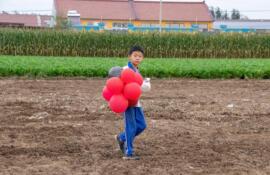It’s 10pm and a tired and famished Jie Li has just arrived home from a long day of programming in Hangzhou, the capital of China’s Zhejiang province. Within minutes he is eating a hot turnip cake, fresh from his freezer.
Like many Chinese households, Jie Li began buying frozen food in bulk at the start of the coronavirus pandemic in early 2020. Reluctant to continue his usual custom of picking up takeaway food on the way home, the 25-year-old turned to frozen food as the virus swept through China and the rest of the world.
“I was surprised to discover that as well as the usual stuff like dumplings, there are a range of really tasty frozen items,” he said. “I now buy a lot of frozen food.”

A delicious frozen shrimp dumpling.

A satisfying and healthy steamed dinner.
Jie Li’s freezer is filled with dumplings, glutinous rice balls, salted egg custard buns, hot dogs, green onion pancakes and turnip cakes. He has very little fresh produce at home.
The covid-19 pandemic breathed new life into China’s stagnant frozen food industry, which had been experiencing slowing growth since 2017. In 2019, the segment grew less than 5% in the face of competition from takeaway food, according to a report by global research company Frost Sullivan.
Within two weeks of the coronavirus pandemic breaking out in February 2020, with restaurant and street food vendors shut, sales of frozen food in China increased by 49%. By the end of 2020, the Chinese frozen food industry had generated sales of ¥175 billion, up from ¥140 billion a year earlier.
Synear Food Co, one of China’s biggest frozen food brands, posted a 30% year-on-year increase in overall sales in the wake of the pandemic, with supermarket sales leaping by 80% in the same period, according to a March 2020 Lengshi Media news report.
Hangzhou Yukang Food Group Co, which sells the Yukang brand of frozen food, posted a 25% increase in sales last year, compared to 15% a year earlier, according to the company’s marketing director Fabin Lin.
Yirui Wang, the duty manager of the Carrefour supermarket in Ziyang City in Sichuan Province, said sales of frozen food at her supermarket reflected the nationwide trend.
“In 2020, this supermarket’s frozen foods sales increased by 33%,” she said. In the first quarter of last year, which included the Chinese New Year period when families traditionally gather for large feasts, the supermarket sold nearly five times as much frozen food as in the same period a year earlier, she said.
Taking advantage of the frozen food trend
As autumn rolled around towards the end of 2021, Carrefour expanded its range of frozen food to take into account Chinese consumers’ seasonal preference for hearty warming dishes and hotpot in cooler weather.
“Our frozen food range now offers customers more choices of dumplings and glutinous rice balls, as well as wider range of richer snack-type items, such as shao mai (steamed crab dumplings) and turnip cake,” Carrefour Ziyang City’s Yirui Wang said.
The most common frozen foods bought by Chinese consumers in 2021 were hot pot items, with 64% of those surveyed buying these items. The next most popular frozen food was meat (bought by 56% of people surveyed), dumplings (purchased by 52%) and glutinous rice balls (50%), according to an October 2021 iiMedia Research report.

Improvements in cold chain technology have also contributed to the expansion in the range of frozen food available in China, with new offerings included steamed buns with barbecued pork, shao mai, spring rolls and regional specialties, such as dried plum and vegetable cake and steamed sweet corn cake.
The iiMedia report found frozen food was popular across all demographics, with 61% of people aged 22-30 willing to buy frozen food and 38% of people aged 41-50 willing to purchase this type of food. Only 2.0% of Chinese consumers have never bought frozen food, the report found.

Fifty-year-old Lan Zhang lives in Ziyang with her son and daughter-in-law and their frozen food purchases differ across the generations. “My son and daughter-in-law like to buy hot pot food so that they can easily cater for their friends when they have parties at the weekend,” Lan Zhang said. “Meanwhile I prefer to buy frozen pastry-type food for breakfast.”
Fei Gao, from Carrefour Ziyang’s public affairs department, said young people’s choice of frozen food is more influenced by price and category, with promotions and novelty categories more likely to get them shopping. French fries and fried chicken tend to be more popular with this demographic. Middle-aged people, on the other hand, prefer frozen food for breakfast, such as traditional pastries and dumplings.
“It turns out that we Chinese do like to eat ‘fresh’, but now we have enriched our categories, consumers can find food they like, regardless of their age. It’s a great start,” Fei Gao said.
Frozen food never stops growing
In the past, convenience was the driving force behind frozen food purchases in China. The pandemic changed that.
According to Fabin Lin, consumer demand for higher-end and regional specialities is growing, and companies are ploughing money into researching and developing new frozen food products to meet this demand.
“We hope to further improve the quality of food, which can make consumers choose it because it is delicious, not just convenient,” Fabin Lin said.
Meanwhile, as the pandemic seems to be dissipating and Jie Li feels more confident socialising, he reaches into his freezer for fish balls, beef and hotpot items so he can entertain some friends with a sumptuous feat.
“I can’t wait to show them these new frozen foods I’ve bought,” he said.





